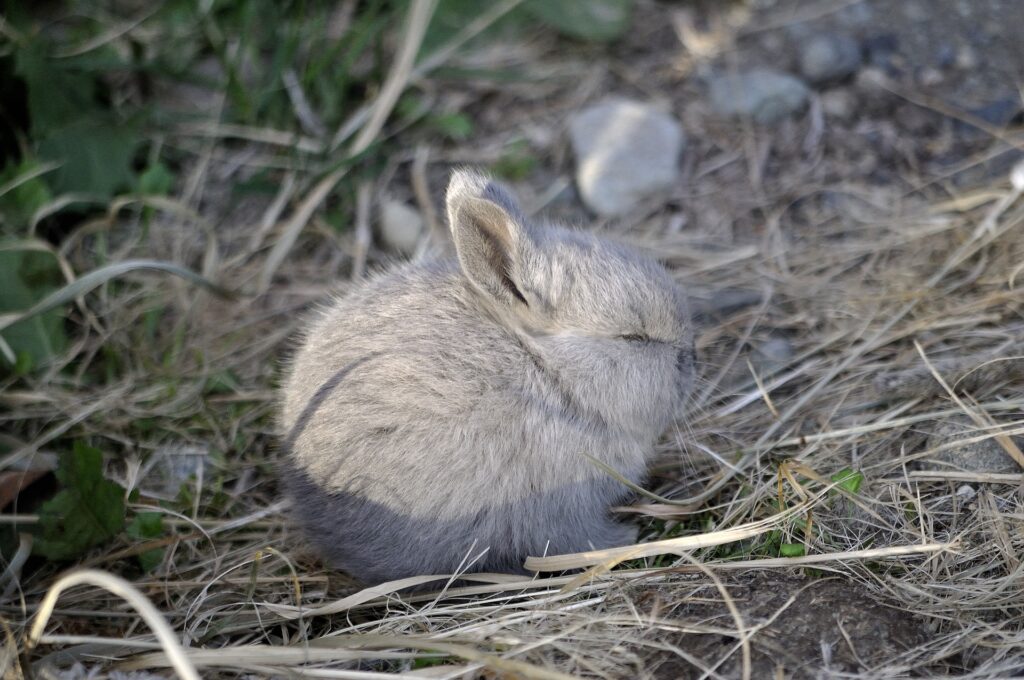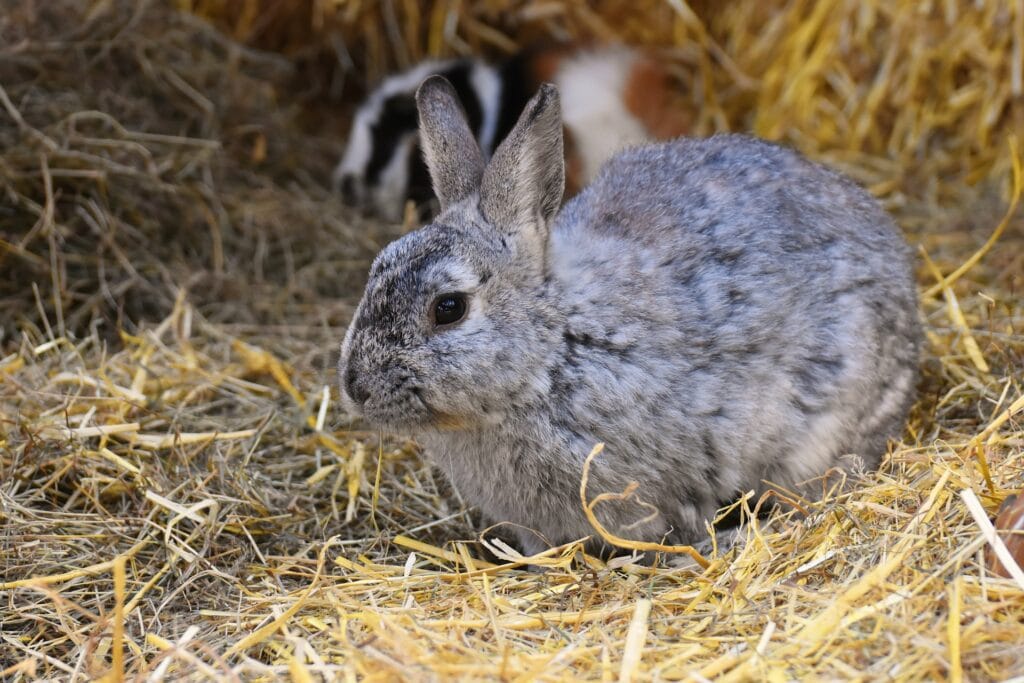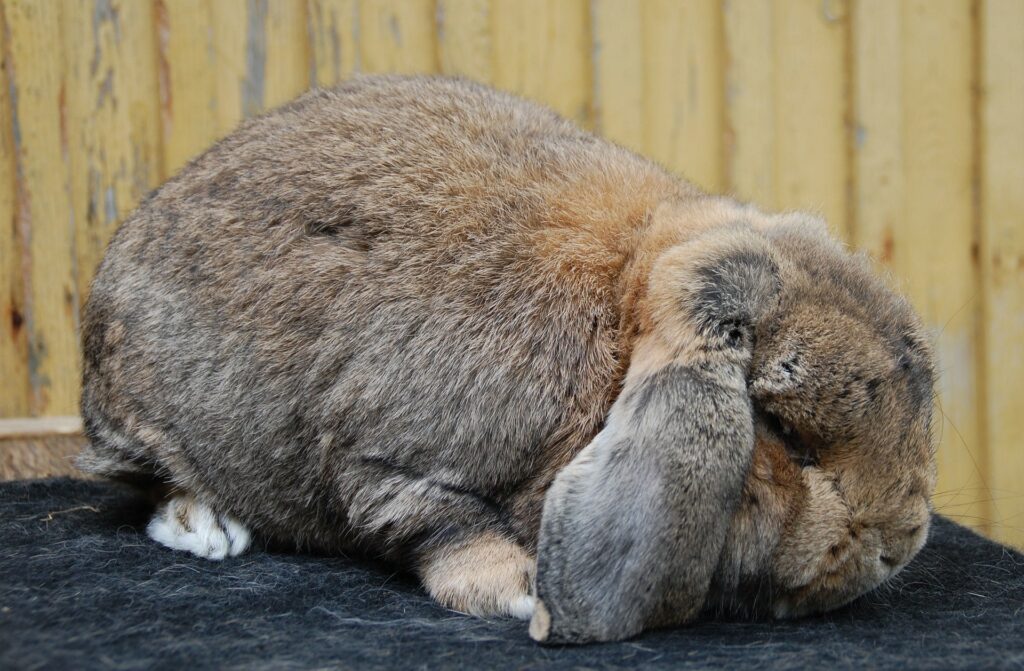Rabbit bedding offers comfort, weather protection, and odor control for your bunny. But some bedding materials are better than others. What makes the best bedding for rabbits? You might be surprised.
Do Rabbits Need Bedding?
Pet owners who have kept other types of small animals, such as rats or guinea pigs, know that they need a safe, comfortable substrate in their enclosures. What about rabbits?
Bedding isn’t essential. However, it can greatly increase your pet’s comfort and protect your rabbit’s feet.
In the case of outdoor rabbits, the right bedding can keep your rabbit warm. Clean rabbit bedding at the bottom of a rabbit’s cage can make your rabbit’s habitat softer and a more comfortable place to sleep.
On top of that, bedding can provide entertainment. Bunnies get bored easily, and making a bed or a nest gives them something to do.
Small animal bedding can also absorb waste and provide odour control.
But it’s not just a matter of picking up a bag of rabbit litter. Rabbit bedding comes in a variety of different materials, and each has its advantages and disadvantages. Some types of bedding can be downright dangerous.
In order to choose the best bedding for rabbits, specifically for your pet rabbits, it’s important to know the facts.
What to Look For
The best bedding for rabbits accommodates rabbits’ behavioural and health peculiarities. Your bunny’s bedding should be…
Safe to Eat
Rabbits love to nibble and chew, and they will nibble and chew almost anything. This means that your rabbit’s bedding material needs to be safe to eat.
Most wood-based rabbit beddings are safe to eat. Avoid cedar wood shavings, however, as they contain volatile chemicals that can harm your rabbit’s health in different ways. Also avoid cat litter, with the exception of litter pellets made from compressed wood or paper.
Dust Free
Dust from different bedding materials can cause respiratory problems. Look for dust-free bedding.
Absorbent
Many rabbits use a litter box. But even those rabbits sometimes “think outside the box.” The bedding inside your rabbit’s hutch should absorb liquid waste. Make sure, however, to replace dirty bedding with fresh bedding in order to keep your rabbit’s enclosure sweet-smelling.
Natural Materials
Natural materials make the most comfortable bedding. They’re less expensive than highly processed bedding, also.
Different From Litter
Your bunny’s bedding should be different from the material with which you line the litter box. This will help your bunny to understand which areas of its enclosure are for sleeping and which are for eliminating.
What to Avoid
Avoid anything that could harm your rabbit if eaten, breathed in, or absorbed. We’ll give you some specifics in a bit.
Top Choices for Rabbit Bedding
The best bedding is the one that your rabbit likes best. There’s a variety of materials that can make great bedding for rabbits. And some of them you may already have at home.
Hay Bedding

We all know that rabbits should eat a diet that’s mostly hay. Many of us struggle with getting rabbits to eat enough of it. Using hay for rabbit bedding means that there’s always some about.
Advantages
There are many reasons hay makes exceptional bedding.
First, most rabbit owners already have a lot of hay on hand.
In addition, hay is inexpensive, and most pet stores carry it.
Having hay strewn about your enclosure encourages your rabbits to eat more of it. And rabbits always need to eat more hay.
Finally, hay is natural, and a natural part of your rabbit’s diet.
Disadvantages
The major downside to hay is that it’s not particularly absorbent. You will have to change hay bedding often.
Straw Bedding

Straw looks like hay, but it’s a bit different. Hay is mowed, dried grass. Straw, on the other hand, is the stalk, seed coverings, dried stems, or leaves that have been separated from the seeds. Straw tends to be drier than hay. It can make an acceptable rabbit bedding, however.
Advantages
Like hay, straw bedding is 100 per cent natural. It’s not a dietary staple like hay, but it is safe to eat. Straw bedding is also on the inexpensive side. Finally, it’s easy for a pet owner to find straw online or at their favourite pet store.
Disadvantages
Straw bedding can create a lot of dust. Look for compressed straw or dust-extracted straw. Also, like hay, straw is less absorbent than some other materials and will need to be changed frequently.
Wood

There are a lot of wood-based beddings on the market, and many are quite good. However, some types of wood do not make the best rabbit bedding, so it’s important to be careful.
Wood Pellets
Wood pellets can make an excellent rabbit bedding. First, they’re highly absorbent. Wood pellets are also natural and safe to eat. Additionally, the heat process used to compress the pellets removes harmful oils and phenols. And wood pellets are virtually dust-free.
Wood pellet cat litter can be an excellent, inexpensive option for rabbit bedding. Alternately, you could use it in your rabbit’s litter box. Just remember not to use the same material for both bedding and the litter box.
Aspen Wood Shavings
Aspen shavings are a safe option, though they can be a bit more expensive than some other types of bedding. Aspen shavings are both super soft and absorbent.
Pine Shavings
You may encounter contradictory advice regarding pine shavings. On one hand, the phenols in pine wood can alter your rabbit’s liver enzymes, which, in turn, can affect the way your rabbit’s body handles medications.
On the other hand, heat drying removes harmful oils and volatiles. So high-quality heat-dried pine shavings could make a safe material for your rabbit’s bedding.
Pine shavings are soft and absorbent. They can provide excellent insulation and make a soft, comfortable nest for your rabbit. At the same time, any type of wood shavings can create quite a cleanup job for the rabbit owner.
Avoid Cedar Wood Shavings
Pine and cedar shavings are often lumped together, but they’re not the same at all.
The aromatic smell of cedar shavings may appeal to us, but it can cause problems for your rabbit’s liver. Cedar can also cause problems for your rabbits if they chew on it or inhale its dust.
Avoid Sawdust
Don’t use sawdust for your rabbit’s bedding. Sawdust gives off dust, which can cause respiratory problems. Also, the sawdust from some types of wood can contain chemicals that can harm your rabbit. Sawdust can also get into your rabbit’s eyes and cause damage there.
Paper Based Bedding
Whether you use shredded paper bedding, paper pellets, or compressed paper, paper-based bedding can make an outstanding bedding for your pet rabbit.
There are specially made commercial paper beddings. But almost any paper will do. Just avoid inks, dyes, glue, labels, tape, and so forth, as these can harm your bunny.
Advantages
Paper bedding has a wealth of advantages.
First, although some types of commercial paper bedding can be expensive, many are quite affordable. You can also use household paper, provided you follow the above safety guidelines.
It’s also easy to find paper for bedding, whether you buy it or recycle it from your household paper.
Paper is also virtually dust free. And it can’t harm your bunny through digestion, absorption, or inhalation.
Paper is a great substrate for indoor rabbits as well as outdoor rabbits. It’s highly absorbent, too.
Finally, you can let your rabbits do the shredding work. In fact, they’ll love it.
Disadvantages
Some forms of paper are better than others. Also, paper bedding isn’t great for odour control, so you’ll need to change it often.
Here are some of the most common forms of paper-based bedding you’ll find.
Shredded Paper
Shredded paper can make excellent bedding. It’s soft, absorbent, and safe to eat, provided you take the safety precautions outlined above. Buy pre-shredded paper, or let your bunnies do the job themselves.
Paper Pulp Bedding
This is a new type of commercial bedding that has a lot of advantages.
First, it’s almost always made from recycled paper or paper pulp. Combined with its biodegradability, this is a very eco-friendly option.
Also, as it’s purpose made, you know it’s safe to eat. And it doesn’t create dust.
Cardboard
Cardboard is an excellent choice for comfortable absorbent bedding, whether you buy commercial cardboard bedding or shred a plain old cardboard box.
For additional fun, you can give your rabbit a whole box and let them rip it up themselves. A lot of rabbits think this is great fun.
This can be an excellent way to recycle delivery boxes and cardboard envelopes. Just remember to remove any staples, labels, tape, glue, ink, etc.
SOME Kinds of Cat Litter
Cat litter may seem like an obvious choice, especially if you’re litter training your bunny. But there are several different types of cat litter, and not all of them are safe for your rabbit.
As we mentioned earlier, wood pellet cat litter can be a great choice for safety, comfort, and absorbency. Paper pellet cat litter can also be a good choice.
But avoid other types of cat litter.
Clay cat litters have a lot of dust, and this can harm your bunny’s respiratory system.
Crystal cat litters can be poisonous. They can also cause digestive problems.
Clumping cat litter can cause great harm to your rabbit’s sensitive digestive system, and can even cause fatal intestinal blockages.
Odour control cat litters have chemicals that may harm your rabbit, as well.
Grass Mat
Rather than using a loose material to line your rabbit’s hutch, consider a grass mat. You can find grass mats online or at your favourite pet store. And, like a cardboard box, a grass mat can provide entertainment as well as comfort and insulation.
Make sure to look for a high quality mat that is free of glue, plastic, and metal.
Advantages
Grass mats are made from grass, hay, or other dried, rabbit-safe plant matter. They’re natural and safe to eat. They can also give your bunny something to chew on and to play with.
Most grass mats aren’t expensive. You can also find them in a variety of sizes.
Disadvantages
Dried grass, like hay and straw, is not particularly absorbent. It can also be difficult to keep clean.
Fabric Bedding

Some people like to use fabric bedding. Fleece blankets and cotton towels are two of the most popular choices.
Advantages
A fleece liner can make cozy bedding for a litter-trained rabbit. Even if your rabbit isn’t litter trained, fleece is quick drying and durable enough to be washed regularly.
Although fleece isn’t technically edible, it won’t harm your rabbit if ingested in small amounts.
The same is true for cotton towels. This can be an excellent way to recycle your bath towels.
Disadvantages
Commercial fleece blankets can be expensive. You can reduce this cost by purchasing fleece by the yard, or by buying a human-sized fleece blanket and cutting it into many blankets that you can switch out regularly.
How Often Should You Change Your Rabbit’s Bedding?
Clean bedding is important for your rabbit’s health and hygiene. Soiled bedding can attract flies, rats, and other pests, as well as encourage mould and mildew growth.
You should already be doing regular hutch maintenance checks. In addition, remove wet or soiled bedding on a daily basis. If you’re using fabric bedding, remove, wash, and replace it at least once per week.
Final Thoughts
When it comes to bedding for your rabbit’s home, you have a lot of choices. Whatever you choose, though, it’s important that your substrate be:
- Safe to eat
- Free from harmful chemicals
- Natural
- Absorbent
- Dust free
It should also be different from the material you use to line your litter tray. It’s good if your subtrate can control odor, but even less absorbent materials can work well if you change them out often enough. Both indoor and outdoor enclosures can benefit from bedding.
What’s your favourite rabbit bedding? Why? Tell us all about it!
















